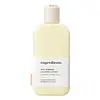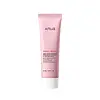What's inside
What's inside
 Key Ingredients
Key Ingredients

 Benefits
Benefits

 Concerns
Concerns

No concerns
 Ingredients Side-by-side
Ingredients Side-by-side

Water
Skin ConditioningGlycerin
HumectantPropanediol
SolventCaprylic/Capric Triglyceride
MaskingCetyl Ethylhexanoate
Emollient1,2-Hexanediol
Skin ConditioningGlyceryl Stearate
EmollientPhenyl Trimethicone
Skin ConditioningC14-22 Alcohols
Emulsion StabilisingPolysorbate 60
EmulsifyingArginine
MaskingCoptis Japonica Root Extract
Skin ConditioningCarbomer
Emulsion StabilisingButylene Glycol
HumectantCorchorus Olitorius Leaf Extract
Skin ConditioningDaucus Carota Sativa Root Extract
Skin ConditioningIlex Paraguariensis Leaf Extract
PerfumingBorago Officinalis Extract
EmollientC12-20 Alkyl Glucoside
EmulsifyingCentella Asiatica Extract
CleansingGlucose
HumectantPolyglyceryl-10 Laurate
Skin ConditioningEthylhexylglycerin
Skin ConditioningTripeptide-1
Skin ConditioningCopper Tripeptide-1
Skin ConditioningPalmitoyl Pentapeptide-4
Skin ConditioningPalmitoyl Tripeptide-1
Skin ConditioningHexapeptide-9
Skin ConditioningHexapeptide-11
Skin ConditioningAcetyl Tetrapeptide-2
Skin ConditioningAcetyl Tetrapeptide-5
HumectantPalmitoyl Tripeptide-5
Skin ConditioningWater, Glycerin, Propanediol, Caprylic/Capric Triglyceride, Cetyl Ethylhexanoate, 1,2-Hexanediol, Glyceryl Stearate, Phenyl Trimethicone, C14-22 Alcohols, Polysorbate 60, Arginine, Coptis Japonica Root Extract, Carbomer, Butylene Glycol, Corchorus Olitorius Leaf Extract, Daucus Carota Sativa Root Extract, Ilex Paraguariensis Leaf Extract, Borago Officinalis Extract, C12-20 Alkyl Glucoside, Centella Asiatica Extract, Glucose, Polyglyceryl-10 Laurate, Ethylhexylglycerin, Tripeptide-1, Copper Tripeptide-1, Palmitoyl Pentapeptide-4, Palmitoyl Tripeptide-1, Hexapeptide-9, Hexapeptide-11, Acetyl Tetrapeptide-2, Acetyl Tetrapeptide-5, Palmitoyl Tripeptide-5
Water
Skin ConditioningDibutyl Adipate
EmollientButyloctyl Salicylate
Skin ConditioningGlycerin
HumectantBis-Ethylhexyloxyphenol Methoxyphenyl Triazine
Skin ConditioningDiethylamino Hydroxybenzoyl Hexyl Benzoate
UV FilterEthylhexyl Triazone
UV AbsorberPhenethyl Benzoate
EmollientPolysilicone-15
UV FilterPropanediol
SolventAlcohol Denat.
AntimicrobialCI 77891
Cosmetic ColorantEthylhexyl Palmitate
EmollientNiacinamide
SmoothingPolyglyceryl-3 Methylglucose Distearate
EmulsifyingMethylene Bis-Benzotriazolyl Tetramethylbutylphenol
UV Filter1,2-Hexanediol
Skin ConditioningSphingomonas Ferment Extract
Skin ConditioningPrunus Persica Fruit Water
MaskingLactobacillus Ferment
Skin ConditioningCitrullus Lanatus Fruit Extract
Skin ConditioningCitrus Paradisi Fruit Extract
Skin ConditioningPrunus Persica Fruit Extract
AbrasivePunica Granatum Fruit Extract
AntioxidantMalus Domestica Fruit Extract
AntioxidantPrunus Persica Flower Extract
MoisturisingSodium Hyaluronate
HumectantHyaluronic Acid
HumectantPentylene Glycol
Skin ConditioningSilica
AbrasiveIsododecane
EmollientOctyldodecanol
EmollientGlyceryl Stearate
EmollientPotassium Cetyl Phosphate
EmulsifyingCetearyl Olivate
Poly C10-30 Alkyl Acrylate
Emulsion StabilisingPolyacrylate Crosspolymer-6
Emulsion StabilisingMicrocrystalline Cellulose
AbsorbentGlyceryl Caprylate
EmollientSorbitan Olivate
EmulsifyingPolyglyceryl-4 Isostearate
EmulsifyingDecyl Glucoside
CleansingSodium Acrylate/Sodium Acryloyldimethyl Taurate Copolymer
Emulsion StabilisingIsopropyl Titanium Triisostearate
EmollientAluminum Hydroxide
EmollientPolyisobutene
Palmitic Acid
EmollientHydrogenated Lecithin
EmulsifyingCellulose Gum
Emulsion StabilisingTrisodium Ethylenediamine Disuccinate
Caprylyl/Capryl Glucoside
CleansingSorbitan Oleate
EmulsifyingButylene Glycol
HumectantCyanocobalamin
Skin ConditioningEthylhexylglycerin
Skin ConditioningAscorbic Acid
AntioxidantLinolenic Acid
CleansingC12-16 Alcohols
EmollientXanthan Gum
EmulsifyingParfum
MaskingCI 77492
Cosmetic ColorantCI 77491
Cosmetic ColorantWater, Dibutyl Adipate, Butyloctyl Salicylate, Glycerin, Bis-Ethylhexyloxyphenol Methoxyphenyl Triazine, Diethylamino Hydroxybenzoyl Hexyl Benzoate, Ethylhexyl Triazone, Phenethyl Benzoate, Polysilicone-15, Propanediol, Alcohol Denat., CI 77891, Ethylhexyl Palmitate, Niacinamide, Polyglyceryl-3 Methylglucose Distearate, Methylene Bis-Benzotriazolyl Tetramethylbutylphenol, 1,2-Hexanediol, Sphingomonas Ferment Extract, Prunus Persica Fruit Water, Lactobacillus Ferment, Citrullus Lanatus Fruit Extract, Citrus Paradisi Fruit Extract, Prunus Persica Fruit Extract, Punica Granatum Fruit Extract, Malus Domestica Fruit Extract, Prunus Persica Flower Extract, Sodium Hyaluronate, Hyaluronic Acid, Pentylene Glycol, Silica, Isododecane, Octyldodecanol, Glyceryl Stearate, Potassium Cetyl Phosphate, Cetearyl Olivate, Poly C10-30 Alkyl Acrylate, Polyacrylate Crosspolymer-6, Microcrystalline Cellulose, Glyceryl Caprylate, Sorbitan Olivate, Polyglyceryl-4 Isostearate, Decyl Glucoside, Sodium Acrylate/Sodium Acryloyldimethyl Taurate Copolymer, Isopropyl Titanium Triisostearate, Aluminum Hydroxide, Polyisobutene, Palmitic Acid, Hydrogenated Lecithin, Cellulose Gum, Trisodium Ethylenediamine Disuccinate, Caprylyl/Capryl Glucoside, Sorbitan Oleate, Butylene Glycol, Cyanocobalamin, Ethylhexylglycerin, Ascorbic Acid, Linolenic Acid, C12-16 Alcohols, Xanthan Gum, Parfum, CI 77492, CI 77491
 Reviews
Reviews

Ingredients Explained
These ingredients are found in both products.
Ingredients higher up in an ingredient list are typically present in a larger amount.
1,2-Hexanediol is a synthetic liquid and another multi-functional powerhouse.
It is a:
- Humectant, drawing moisture into the skin
- Emollient, helping to soften skin
- Solvent, dispersing and stabilizing formulas
- Preservative booster, enhancing the antimicrobial activity of other preservatives
Butylene Glycol (or BG) is used within cosmetic products for a few different reasons:
Overall, Butylene Glycol is a safe and well-rounded ingredient that works well with other ingredients.
Though this ingredient works well with most skin types, some people with sensitive skin may experience a reaction such as allergic rashes, closed comedones, or itchiness.
Learn more about Butylene GlycolEthylhexylglycerin (we can't pronounce this either) is commonly used as a preservative and skin softener. It is derived from glyceryl.
You might see Ethylhexylglycerin often paired with other preservatives such as phenoxyethanol. Ethylhexylglycerin has been found to increase the effectiveness of these other preservatives.
Glycerin is already naturally found in your skin. It helps moisturize and protect your skin.
A study from 2016 found glycerin to be more effective as a humectant than AHAs and hyaluronic acid.
As a humectant, it helps the skin stay hydrated by pulling moisture to your skin. The low molecular weight of glycerin allows it to pull moisture into the deeper layers of your skin.
Hydrated skin improves your skin barrier; Your skin barrier helps protect against irritants and bacteria.
Glycerin has also been found to have antimicrobial and antiviral properties. Due to these properties, glycerin is often used in wound and burn treatments.
In cosmetics, glycerin is usually derived from plants such as soybean or palm. However, it can also be sourced from animals, such as tallow or animal fat.
This ingredient is organic, colorless, odorless, and non-toxic.
Glycerin is the name for this ingredient in American English. British English uses Glycerol/Glycerine.
Learn more about GlycerinGlyceryl Stearate is a mix of glycerin and stearic acid.
It is used to stabilize the mixing of water and oil ingredients. By preventing these ingredients from separating, it can help elongate shelf life. It can also help thicken the product's texture.
As an emollient, it helps soften skin and supports barrier-replenishing ingredients.
In cosmetics, Glyceryl Stearate is often made from vegetable oils or synthetically produced.
This ingredient may not be fungal-acne safe
Fun fact: The human body also creates Glyceryl Stearate naturally.
Learn more about Glyceryl StearatePropanediol is an all-star ingredient. It softens, hydrates, and smooths the skin.
It’s often used to:
Propanediol is not likely to cause sensitivity and considered safe to use. It is derived from corn or petroleum with a clear color and no scent.
Learn more about PropanediolWater. It's the most common cosmetic ingredient of all. You'll usually see it at the top of ingredient lists, meaning that it makes up the largest part of the product.
So why is it so popular? Water most often acts as a solvent - this means that it helps dissolve other ingredients into the formulation.
You'll also recognize water as that liquid we all need to stay alive. If you see this, drink a glass of water. Stay hydrated!
Learn more about Water